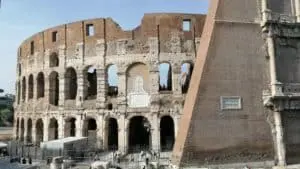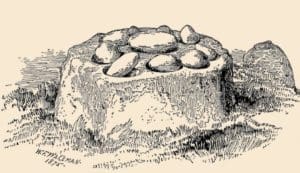Sunken Cities: Dive Into the Depths of Lost Civilisations

Updated On: April 20, 2024 by Raghda Elsabbagh
Beneath the waves lies a hidden tapestry of human history, interwoven with myths, legends, and the stark reality of past civilisations. Sunken cities around the globe captivate our imagination, each with its own story of glory and eventual demise. These underwater metropolises, often lost due to natural disasters or the inexorable rise of water levels, provide an eerie snapshot of life as it was centuries, or even millennia, ago. They stand as submerged monuments to human endeavour, frozen in time and brimming with secrets waiting to be unravelled by intrepid explorers.

The discovery and exploration of these cities offer a unique view into the past. Egypt’s sunken treasures, for example, provide unprecedented insights into ancient trade, cultural exchange, and the daily life of past epochs. Techniques in underwater archaeology continue to evolve, bringing to light artefacts and structures that piece together the narrative of once-thriving communities. Today, our ability to preserve and protect these precious sites is more critical than ever, ensuring that they endure for future generations to marvel at and learn from.
Table of Contents
The Allure of Sunken Cities
The narrative of sunken cities fascinates us, capturing our imagination with mysteries veiled beneath the waves. Each city’s submergence whispers tales of a bygone era, beckoning historians and adventurers alike to unravel its secrets.
Underwater Enigmas: The mysteries that shroud these ancient ruins are as alluring as the cities themselves. They symbolise the juxtaposition of human achievement and nature’s overpowering force. The remnants, now playgrounds for marine life, once teemed with human activity.
Heraklion’s Legacy: The city of Heraklion, lost to the sea, tempts us with its preserved temples and statues. Its existence intertwines with mythology and historical milestones, allowing us to touch a part of our ancient past.
Global Fascination: From Egypt to India, the global tapestry of sunken cities narrates the story of humanity across different continents. The astonishing details of architectural prowess stand in stark contrast with their submerged state.
| Sunken City | Notable Features |
|---|---|
| Heraklion | Submerged ruins |
| Dwarka | Ancient pillars and pottery |
| Alexandria | Cleopatra’s royal quarters |
Our exploration of these underwater marvels is more than mere curiosity—it’s a profound connection to the continuous thread of human history. These cities beneath the sea encapsulate the essence of civilisations that have shaped our world, and they continue to captivate us with their enduring mystery and beauty. Through understanding their stories, we deepen our appreciation for the intricate tapestry of our shared heritage.
Legends Versus Reality
In our pursuit of understanding sunken cities, we often navigate the fine line between legends and reality. Famous tales, like those of Atlantis, have long captured our imaginations. Atlantis, as described by Plato, is the epitome of an advanced utopian society that, after falling out of favour with the gods, was said to have sunk into the ocean. This enduring myth has sparked countless expeditions and debates about its existence and location.
The reality, however, presents us with tangible evidence of submerged urban landscapes. One such example is Thonis-Heracleion. Located in Egypt’s Abu Qir Bay, it was once a bustling port city. It’s a veritable time capsule, offering a wealth of artefacts and insights into the ancient world, like the mysteries of Osiris—an Egyptian deity intimately linked with the afterlife and whose cult was prominent in Thonis-Heracleion.
Here’s a snapshot of how legend and reality intersect:
| Legend | Reality |
|---|---|
| Atlantis: Enthralling utopia | Thonis-Heracleion: A real port city |
| Cataclysmic sinking by divine wrath | Earthquakes and gradual subsidence |
| Believed location varies | Discovered off the coast of Egypt |
| Mysteries of Osiris are often metaphorical | Celebrations actually occurring in Thonis-Heracleion |
We have the privilege of examining these relics and structures beneath the waves, piecing together their past and, in doing so, separating fact from fiction. For instance, recent underwater archaeology has presented irrefutable proof of Thonis-Heracleion’s existence and significance in antiquity. Through these discoveries, we’re continually rewriting history, shaping our understanding of ancient civilisations. These underwater worlds open doors to past rituals, economies, and social structures that once thrived on the edge of the ancient world.
Underwater Archaeology: Unveiling the Past
Underwater archaeology has allowed us to uncover astonishing facts about long-lost cities submerged underwater. Notable figures like Franck Goddio have been instrumental in this quest, uncovering artefacts that redefine our understanding of history.
Pioneering Explorers
Underwater archaeologists like Franck Goddio have led the way in exploring the remains of sunken metropolises. Goddio’s excavations of the ancient Egyptian city of Thonis-Heracleion have brought to light significant artefacts and structural elements that alter our perception of antiquity.
Innovative Techniques
Innovative methods in underwater archaeology employ sonar scanning, submersibles, and cutting-edge diving equipment to retrieve relics from the depths safely. These techniques ensure delicate artefacts are meticulously recorded and preserved, providing invaluable insights into the maritime trade routes and cultural exchanges of past civilisations.
We carefully apply these strategies, appreciating that each submerged object, from pottery shards to colossal statues, holds clues linking us to our rich and diverse heritage.
Egypt’s Sunken Treasures
In Egypt’s rich underwater realms, profound tales of ancient history are being brought to the surface, revealing vibrant cities and sacred temples that had once slipped from memory into the depths of the Mediterranean.
Alexandria: A Submerged Historical Hub
Known as the Pearl of the Mediterranean, Alexandria was a beacon of knowledge and culture during the Ptolemaic Dynasty. Recent underwater explorations have brought to light numerous artefacts from this illustrious period. They confirm the city’s status as a major historical hub, with objects that range from colossal statues to everyday items, which now tell a story of the city’s past vibrancy and grandeur.
Thonis-Heracleion and Canopus: Egypt’s Lost Cities
Thonis-Heracleion and Canopus, once bustling with activity, now lie submerged off the coast of Egypt. Their discovery transformed our understanding of the religious practices of the time, with findings including inscriptions dedicated to Isis and Osiris. These cities offer an unparalleled glimpse into the rituals and celebrations, such as the Mysteries of Osiris, that were integral to the religious life during the late Ptolemaic period.
Artefacts and Temples
The seabed near Alexandria has been especially generous, yielding artefacts such as coins bearing the likenesses of Ptolemaic rulers and delicate glassware that speaks to the craftsmanship of the era. Temples, including that of the god Amun-Gereb, the supreme deity of the now-submerged cities, have emerged from the depths, with their vast stone blocks and inscribed steles recounting the power and piety of the times. These discoveries reveal an interconnected world where the reverence for the divine shaped all aspects of daily life.
Globetrotting: Sunken Cities Worldwide
As we explore the depths of our planet’s waters, we uncover the silent cities that the sea has claimed. From the Eastern mysteries to the sunken treasures of the West and America’s own underwater enigmas, these submerged metropolises offer a haunting look into our past.
The Eastern Enigma: Dwarka and Lion City
The ancient city of Dwarka, also referred to as the ‘Atlantis of the East’, reveals a civilisation steeped in mythology and history. Lion City (Shi Cheng), submerged underwater for the sake of a hydroelectric power project, retains a grandeur that captures the essence of Eastern antiquity, nestled beneath China’s Qiandao Lake.
- Dwarka: Believed to be the kingdom of Lord Krishna and mentioned in ancient texts.
- Shicheng (Lion City): Over 50 years underwater, yet its majestic architecture still astounds divers.
Western Depths: Port Royal and Baia
Once coined, ‘the wickedest city on Earth’, Port Royal was lost to the depths during a catastrophic earthquake in 1692. In stark contrast, the Roman city of Baia was a haven for the elite, its luxury now lying below the Bay of Naples.
- Port Royal: Jamaica’s sunken pirate city, a preserve of underwater archaeology.
- Baia: Italy’s submerged sanctuary of the ancient rich and powerful.
America’s Underwater Secrets
Off Cuba’s coastline rests secrets yet to be fully unveiled, while closer to our own backyard lies evidence of human settlements between 7,000 and 15,000 years old, challenging our understanding of prehistoric America.
- Cuba: Plates shift, sea levels rise, and cities are engulfed, potentially concealing another ‘Atlantis’.
- America’s submerged sites: Offer glimpses into ancient pre-Columbian history, now veiled by water.
Natural Disasters and Sunken Settlements
Natural calamities have long been a catalyst for the submergence of cities, reshaping the geography of human settlements. Earthquakes, in particular, have been formidable in their ability to sink land and the cities built upon them in a matter of moments. These seismic events precipitate the ground to liquefy, a phenomenon that can cause buildings and structures to collapse and settle beneath water levels.
Tsunamis are another potent force of nature, spawned often by underwater earthquakes. Their massive waves surge forth with immense energy, overwhelming coastal areas and capable of dragging portions of cities into the sea. Historical accounts and archaeological discoveries have confirmed the role of tsunamis in the destruction and eventual submersion of ancient settlements.
Rising sea levels also contribute significantly to the gradual but relentless encroachment of water upon land. Primarily driven by global warming, the increase in sea levels slowly submerges coastal settlements over time, leaving behind only remnants of once thriving communities below the water’s surface.
Finally, storms, with their accompanying high winds and surging waters, have the power to erode coastlines and inundate cities. Often, the combined effect of multiple storms over time can weaken the structural integrity of a city, leading to its eventual descent beneath the waves.
Here is an overview of how these events affect settlements:
- Earthquake: Causes ground liquefaction, leading to the collapse of structures
- Tsunami: Generates powerful waves that can engulf and pull down coastal cities
- Rising Sea Levels: Slowly submerges land, overtaking cities over extended periods
- Storms: Erode coastlines and can compromise a city’s defences against the sea
We must understand the might of these natural events and their role in shaping our world’s geography, especially as we explore the fascinating mysteries of sunken cities. Through meticulous study, we not only unlock past tales hidden beneath the waves but also arm ourselves with critical knowledge to protect our current settlements from suffering a similar fate.
Cultural Influence and Mythology
Sunken cities often capture our imaginations with their enduring myths and cultural influences. In many parts of the world, these submerged cities are richly intertwined with folklore and historical narratives that continue to fascinate us.
One such city is Heraklion, also known as Thonis-Heracleion. It was a vital hub for trade and commerce between Egypt and the Mediterranean world. The city not only bears historical significance but also features prominently in ancient mythology. It is often associated with Heracles, a figure prominent in both Roman and Greek mythology.
The influence of these sunken cities extends beyond their local cultures. For example, the legend of Krishna, a major deity in the Hindu tradition, includes the city of Dwarka. This city is said to have been submerged in the sea, which parallels the narratives of other mythical sunken cities in different cultures.
Additionally, sunken cities can shed light on the mysteries of spiritual and ceremonial practices. The discoveries in Heraklion helped researchers understand the Mysteries of Osiris, an annual water celebration in ancient Egypt. These cities not only tell us about trade and daily life but also about the ceremonial and spiritual lives of ancient civilisations.
While the mythology of sunken cities is compelling, we also understand the importance of factual accuracy. We acknowledge that mythical cities like Pongos are less documented and may not have the same historical evidence as other more well-known sunken cities. Our fascination with these stories continues to drive exploration and discovery, as well as a deeper appreciation of human history and culture.
Maritime Trade and Its Impact
We’ve observed throughout history the transformative power of maritime trade on civilisations around the world. Notably, sunken cities often owe their growth and prosperity to their roles as pivotal trading ports. For example, the bustling commerce along the Nile was central to Egypt’s economy, with an extensive network facilitating the exchange of goods like papyrus, grains, and precious metals.
Maritime Trade: A Catalyst for Growth
- The economies of ancient cities often hinged on the success of their maritime trade.
- Access to navigable waterways allowed trading ports to thrive and become hubs of cultural exchange.
- The movement of goods fostered not only economic wealth but also the cross-pollination of ideas and technologies.
Trading Ports: Centres of Commerce
- Cities located along the coast or riverbanks had a strategic advantage in controlling trade routes and goods.
- The success of a trading port fuelled urban development, expansion, and infrastructure.
| Aspect | Impact |
|---|---|
| Economy | Boosted by import and export |
| Society | Diverse due to converging trade routes |
| Culture | Enriched with foreign goods and practices |
The Nile: Artery of Trade
Trading on the Nile demonstrated the river’s role as a lifeline for Egypt. It facilitated internal trade and connected Egypt with the wider Mediterranean world. The consistent flow of goods and resources along the Nile was crucial for sustaining ancient Egyptian civilisation.
These sunken cities, relics of a bygone era, encapsulate the monumental impact that maritime trade has had on societal development. In uncovering them, we uncover the stories of ancient societies sculpted by the ebb and flow of commerce.
Preservation and Protection Efforts

In the realm of submerged antiquities, preservation and protection are paramount. Our efforts span various methodologies, ranging from physical barriers to advanced technological monitoring.
Underwater Museums: The creation of underwater museums not only serves to protect precious artefacts from looting and environmental damage but also educates the public. By encouraging regulated visits to these sites, we safeguard our heritage while making it accessible.
Marine Archaeologists: These specialists are at the forefront of conservation. Utilising meticulous techniques, they ensure minimal disturbance to the surroundings during excavation and documentation.
Institutes and Collaborations: Our work closely aligns with the objectives of the European Institute for Underwater Archaeology (or IEASM), which has been instrumental in key discoveries and ongoing site management.
| Entity | Role in Preservation |
|---|---|
| Underwater Museums | Cultural awareness, artefact protection |
| Marine Archaeologists | Excavation, documentation, conservation |
| IEASM | Research, education, policy advocacy |
Our collective endeavours ensure that the marvels of these subaquatic cities remain not only as vestiges of the past but as beacons for future generations to cherish and learn from.
Exploring Underwater Ruins
The mysteries of the ocean have always captured human imagination. With advancements in diving technology, we have been granted unprecedented access to explore these submerged secrets, revealing the echoes of ancient civilisations.
The Rise of Recreational Scuba Diving
Over the years, the popularity of recreational scuba diving has soared, offering us a unique means to witness history beneath the waves. Diving is not just a pursuit of sporting thrill but also an educational experience as divers become amateur archaeologists, exploring ruins that tell stories millennia-old. Many of these excursions are not solely for experienced divers – beginners can also partake in guided tours that make undersea exploration accessible to a broad audience. We find ourselves gliding through the water alongside submerged structures that have rested untouched for aeons, providing insight into the lives of bygone societies.
Underwater Museums: Displaying Subaquatic History
Underwater museums have emerged as a brilliant way to curate the sunken vestiges of the past. Take, for instance, the Museum of Underwater Sculpture Ayia Napa in Cyprus, where art meets history in the depths of the Mediterranean. These museums are not static; they are dynamic spaces where marine life interacts with historical artefacts, offering a living diorama of the past. The experience of diving into these aquatic galleries is transformative, connecting us with the passage of time in a way that traditional museums cannot replicate. It’s an immersive learning experience where every swim through these watery halls deepens our connection to the past.
The Future of Underwater Exploration

As we peer into the crystal waters of our world’s oceans, lakes, and seas, we stand on the cusp of a new era in underwater exploration. Technological advancements are propelling marine archaeology to impressive new depths, allowing us to unveil the mysteries that have slumbered beneath the surface for centuries.
- Robotics and Automation: Unmanned robotic divers and autonomous underwater vehicles (AUVs) can be programmed to perform complex tasks, staying submerged for prolonged periods which surpass human limitations.
- Advances in Imaging: The development of high-resolution sonar and photogrammetry techniques offers us detailed maps of underwater landscapes, enabling the discovery and study of sites like the sunken city of Heraklion. Explore its discovery
- Materials and Preservation: Innovative materials and preservation techniques are improving the way artefacts are conserved once they are exposed to air after thousands of years underwater.
With these tools at our disposal, marine archaeology stands to benefit greatly. Our understanding of ancient civilisations and historical events will be enriched as we unlock secrets from shipwrecks, submerged cities, and ancient artefacts resting on the seabed.
Moreover, recent initiatives by notable organisations, such as NASA, delve into the depths for reasons that span beyond archaeology. By studying Earth’s deepest oceans, we’re gaining insights into extraterrestrial aquatic environments, enhancing our search for life beyond our planet. This cross-disciplinary approach highlights the multifaceted value of underwater exploration. Learn why NASA is exploring our oceans.
In essence, the future shines with promise, fuelled by the synergy between technological advancements and the insatiable human drive to explore. We envision a world where the unexplored, dark recesses beneath the waves become accessible, casting light on our past and opening doorways to the future.
Frequently Asked Questions
In this section, we’re delving into some of the most intriguing queries surrounding the world’s sunken cities. These are the questions enthusiasts and scholars frequently ponder.
Which submerged city is considered the most renowned globally?
The most renowned submerged city globally is often thought to be the fabled Atlantis, highly debated amongst historians and explorers alike. While its existence has not been proven, the allure of this legendary city continues to captivate imaginations.
Have there been any recent discoveries of submerged urban settlements?
Recent discoveries have unveiled new submerged urban settlements, with archaeologists unearthing Egypt’s lost worlds, such as Thonis-Heracleion and Canopus, which offer great insights into ancient civilisations and their eventual descent beneath the waves.
Can you name some ancient cities that are now beneath the sea?
Ancient cities like Thonis-Heracleion, Canopus, and part of the Nile Delta, as well as Pavlopetri in Greece, are examples of once-thriving metropolises that now lie beneath the sea, serving as underwater museums of past eras.
What certain myths pertain to the phenomenon of sunken cities?
Myths surrounding sunken cities often include tales of divine retribution or catastrophic natural disasters. Egypt’s lost cities carry myths intertwined with the gods, speaking to the power and wrath they held over these ancient places.
Is there a factual basis for the legend of underwater cities?
While legends like Atlantis remain unverified, the factual basis for underwater cities is solidly grounded with cities such as Thonis-Heracleion and Canopus, which were once bustling hubs of activity before succumbing to the sea.
What documentaries explore the subject of submerged cities?
Numerous documentaries explore the subject, providing vivid accounts and underwater footage of these mysterious ruins. They educate audiences about the complex history of civilisations that now rest beneath the oceans.






